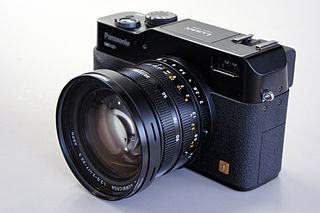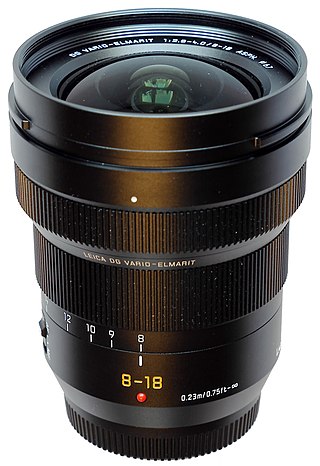
The Four Thirds System is a standard created by Olympus and Eastman Kodak for digital single-lens reflex camera (DSLR) and mirrorless camera design and development.

Lumix is Panasonic's brand of digital cameras, ranging from pocket point-and-shoot models to digital SLRs.
Walter Mandler was a lens designer of Ernst Leitz Canada in Midland, Ontario. Mandler is credited with the design of more than 45 Leica lenses for the Leica rangefinder cameras and Leica SLR cameras.

The name Elmarit is used by Leica to designate camera lenses that have a maximum aperture of f/2.8.

A mirrorless camera is a digital camera which, in contrast to DSLRs, does not use a mirror in order to ensure that the image presented to the photographer through the viewfinder is identical to that taken by the camera. They have come to replace DSLRs, which have historically dominated interchangeable lens cameras. Other terms include electronic viewfinder interchangeable lens (EVIL) cameras and compact system cameras (CSCs).

The Digilux 2 is a digital camera model sold by Leica Camera, with the body manufactured in Japan by Matsushita, which sold a variant as the Panasonic Lumix DMC-LC1. Its image sensor is a CCD with 5.24 million total pixels. It has a color, transreflective thin-film transistor liquid crystal display with 211,000 pixels, in addition to an electronic viewfinder. It has a near-focus range of 30 centimeters. The camera has a built-in flash. This flash, first of its kind, has the ability to be pointed up, as well as the standard method of pointing straight ahead, in order to "bounce" the light off a ceiling. The camera weighs 630 grams. Its dimensions are 135 millimeters in width, 82 millimeters in height, and 103 millimeters in depth. The camera is fitted with a Leica Vario Summicron lens of f/2 with a zoom function of 28mm - 90mm in 35mm format.

The name Summicron is used by Leica to designate camera lenses that have a maximum aperture of f/2 after 1953 and to present day.

Nocticron is the brand name of Leica lenses with an extreme speed of f/1.2. Because of the large aperture size and its image stabilisation system it is possible to take images with relatively short exposure time especially in available light situations. Together with the high number of nine diaphragm blades the lens creates a strong and pleasant bokeh.
The Panasonic Leica D Vario-Elmar 14-150mm F3.5-5.6 Asph Mega OIS is an interchangeable camera lens announced by Panasonic on March 7, 2007. Since it has been released, it was only produced in small quantities, which makes this product quite special. It features the Four Third Systems to assure its compatibility with different camera models.

The Panasonic Leica D Vario-Elmarit 14-50mm F2.8-3.5 ASPH Mega OIS is an interchangeable camera lens announced by Panasonic on February 26, 2006. It was the first Leica lens with optical image stabilisation.

The Leica L-Mount is a bayonet mount developed by Leica Camera AG for interchangeable-lens autofocus digital cameras.

The Panasonic Leica DG Vario-Elmarit 8–18 mmf/2.8-f/4.0 lens is a digital compact ultra wide angle lens for Micro Four Thirds system cameras. It is a varifocal lens branded with the German label Leica, but manufactured by Panasonic in Japan.

The name Summilux is used by Leica and Panasonic Lumix to designate camera lenses that have a maximum aperture of less than f/2, typically f/1.4, but greater than f/1.0. The lens has been in production since 1959 and carries on to the present day.

The name Summarit is used by Leica to designate camera lenses that have a maximum aperture of f/2.4. The name has been in used since 1949.

The name Elmar is used by Leica to designate camera lenses of four elements that have a maximum aperture of f/3.98 or f/4.0.
The Leica SL2 is a full-frame mirrorless interchangeable-lens camera released by Leica Camera on 6 November 2019. The camera uses the Leica L-Mount lenses range and is part of the L-Mount Alliance of camera bodies that Leica co-developed with Panasonic and Sigma.
The Leica S-System is a medium format digital single lens reflex camera system introduced by Leica Camera in 1996. Beginning with the Leica S1, a prototype top-end studio digital camera unveiled at Photokina 1996. It went into production at the end of 1997.














